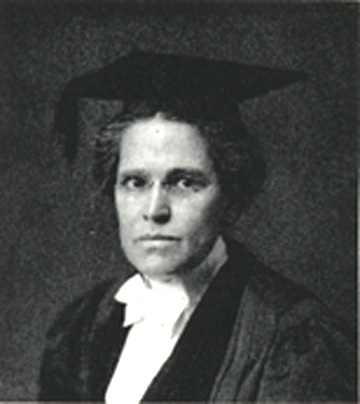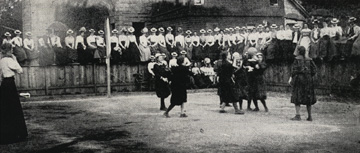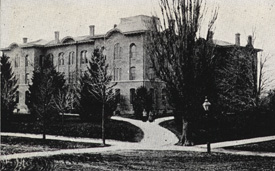






By Minnie Lynn, alumna of Oberlin College, class of 1928 - "professor and director of teacher education, health, and physical education for women at the University of Pittsburgh. She holds a M.S. degree from Pennsylvania State College and a Ph.D. from the University of Pittsburgh. A former president of the Eastern District of the American Association of Health, Physical Education, and Recreation, she was the recipient of an honor award from that organization in 1953, the same year that Oberlin College honored her with an Alumni Citation."
Oberlin Alumni Magazine , July 1957, pp 22-25.
 There is something ageless and prophetic in the portrait
of Dr. Delphine Hanna, in academic garb, re-flecting the objective
detachment of the scientist, the hu-manitarian instinct of the
physician, the insight of the visionary educator, the inspiration of
the architect of ideas with a future. Sound purpose and excellence of
perform-ance in pursuit of it characterized her endeavor. The courage
for pioneering and the vitality of forthright lead-ership were never
bound by the role of a single profession nor the stereotyped concepts
of her times.
There is something ageless and prophetic in the portrait
of Dr. Delphine Hanna, in academic garb, re-flecting the objective
detachment of the scientist, the hu-manitarian instinct of the
physician, the insight of the visionary educator, the inspiration of
the architect of ideas with a future. Sound purpose and excellence of
perform-ance in pursuit of it characterized her endeavor. The courage
for pioneering and the vitality of forthright lead-ership were never
bound by the role of a single profession nor the stereotyped concepts
of her times.
It was the holiday season in 1936 when I stood at a door in Coral Gables awaiting an answer to my knock. Before me was the long-anticipated meeting with Delphine Hanna, M D. I was admitted to the study and told to wait until I had been properly announced.
As I entered Dr. Hanna's presence, I noted a comfortable library-study, with a hospital bed at one end, its head raised to support a frail figure. The piercing eyes which studied me with careful scrutiny were nevertheless bright with in-terest. In Washington on my way to Florida I had called upon one of Dr. Hanna's most renowned students. She had counseled me, "Wear the ensemble you are wearing now for your interview. It combines her favorite colors, old gold and purple." In the long, silent moments of in-spection I knew not only that the favorite colors had been noted but that my bearing, poise, and integrity of my pur-pose had been duly assessed. Then, with firm handclasp, in a crisp but not uncordial voice, she said, "Be seated and ask your questions clearly. Remember this interview may be interrupted by temporary emergency and must be in-terspersed with rest periods."
In partial fulfillment of the degree of Master of Science, I had elected to write an historical analysis of her profes-sional career. As an undergraduate at Oberlin I had been steeped in the fascinating lore of her pioneering venture in physical training at Oberlin College. To me it was more colorful than the saga of Peter Pindar Pease.
But to the announcement of my intention to write a biographical thesis, Dr. Hanna had written from Coral Gables: "I do not want my biography written. If my work was worthy it is still in progress." As I prepare now, to take my interview notes, I recalled cheerfully, I had also received a belated postcard. It read, "I have not heard from you. When do you plan to arrive in Florida? Sincerely, Delphine Hanna." I had lost no time in buying my ticket.
It was the bitter cold winter of 1884. In the township school in upstate New York a young teacher watched the last pupil reluctantly leave the genial warmth of the well-kept fire in the class room to trudge home through the deep snow. Each week it had been apparent that fewer pupils could weather the wintry blasts, and, like their teachers, even the faithful few grew more and more listless. A vague memory of her own lassitude during the long winter confinements of her childhood in Wisconsin stirred in her mind the question "Why?"
Dio Lewis, popular lecturer and doctor, was on tour, interpreting the "new" physical training to the masses. Miss Hanna learned he would be present at the summer institute at Martha's Vineyard. Were her observations relevant to the thesis he was advancing? She attended, but upon broaching her hypothesis that there might well be a scientific basis on which physical training could be founded she was shocked with Dio Lewis' summary reply: 'You don't need a scientific basis. People want to be hum-bugged."
That Fall she returned to her school in upstate New York, but the question recurred as she looked at the pale faces, the fatigued bearing of her pupils. After ten weeks she took a leave, again seeking an answer in physical training.
At Harvard University, young Dr. Dudley Sargent had interested a benefactor, in making a generous gift to erect a well-equipped gymnasium. The testing, the courses, the activities were an innovation on a college campus. In hours free from concern for Harvard men, Dr. Sargent envisioned the application of his theories to the formative years of childhood. Consequently he was willing to conduct classes for women teachers in a room above a carriage shop, lecturing on anatomy, physiology, and the theory of exercise. Delphine Hanna had prevailed upon others to join her, and twelve young women were enrolled that year.
She also investigated the newly-developing orthopedic center in Boston. Paying five dollars an hour, she studied diagnostic and corrective prescription for spinal deviations with Dr. Bradford. This initiated a long and significant connection with the pioneers in orthopedics, including doctors Goldthwaite, Lovett, and Brockect. Her love of the theatre and music was also established that year. Her personal annals disclose, "I ... saw Henry Irving and Ellen Terry in Twelfth Night and Walter Damrosch conduct Lohengrin and Tannhauser."
By now it was quite clear she had chosen her life work. She was now convinced that a regimen of exercise was essential to well-being, but it must be based on scientific principles. It was to a small midwestern college in Oberlin, Ohio, reported to welcome with open mind experimentation in newer educational theories, that Delphine Hanna brought her convictions.
Unmoved by the lament of her school principal, "but you are a teacher in a thousand," Miss Hanna gave up the lucrative salary of $800 to accept Oberlin's guarantee of $300 for living expenses for the year 1886. At Oberlin, women students had conducted calisthenics in the assembly room of Ladies Hall since 1850. Later, Music Hall had been remodeled to provide space for exercise. In 1880, when fire destroyed the frame building, students and faculty had clamored for an addition to Ladies Hall, the first floor of which might be set aside for a women's gymnasium. It was to this red brick building that President Fairchild conducted Delphine Hanna. Her own description relates:
There were five dressing places partitioned off from the north end of the room, with dirty red curtains in front of them. On top was piled a camping outfit . . . in one corner was a pile of oats; on the walls were various crude drawings. These I had removed and the room thoroughly cleaned.
Her own room was one of ten in the dormitory floor above, about which she writes:
The room contained a black bedstead with husk mattress six inches too short, a wash-stand with pitcher and bowl, two chairs and a rack of wood. It was customary for the occupant to rent a bureau, but after some discussion one was provided out of deference for my pedagogical status.
She too had found a benefactor who donated $300 to equip the space for "well-prescribed exercise." Most of it went to the Naragansett Machine Company for pulley weights and mechanical aids for physical examinations. She supervised two handymen in the construction of a boom, stall bars, a floor rack, and vertical ladder. These outstood years of usage and were intact when the building was razed several decades ago.
Mindful of her tenet of scientifically founded programs, she examined 125 women and grouped them into exercise classes. Records were meticulously filed with respective prescription cards. Copies were sent to Dr. Sargent to be used in his studies on testing, but primarily the findings were tabulated on the first Hanna anthropometric charts, based on the examination of 1600 college women and published in 1893. The comparative graphs were carefully studied to ascertain the effects of participation in the physical training program. Data were constantly processed and submitted for national research studies in education, orthopedics and medical science.

It is almost impossible to train a portrait-lens on the energetic figure of Delphine Hanna in the ensuing years. Though indefatigable in behalf of physical education and the preparation of teachers, she was equally zealous to improve her own professional status and to achieve appropriate recognition of the competence of women. In 1887 she attended summer sessions at Harvard, and took entrance examinations for credit at Michigan, completing medical school in two years. She was among the first of the "hen medics" and subsequently was named to the Michigan Hall of Fame. In 1898 she entered Cornell University to acquire a Bachelor of Arts Degree; in the meantime she had studied the Swedish gymnastic system with Baron Passe and additional orthopedic work in Zurich. In 1901 in recognition of her outstanding studies and publications of anthropometric charts, Oberlin College bestowed the Master of Arts Degree upon her.
Simultaneously she was building the department of physical education at Oberlin and sending trained leaders into the profession throughout the country. In her second year at Oberlin she instituted the preparation of teachers. By 1900 the original one-year diploma course had become a major in physical education open to candidates for the A.B. degree. Dr. Hanna is credited with establishing the first four-year curriculum for teachers leading to a degree. In the earliest years, young men on the campus sought the opportunities in physical education under her tutelage. With too little time to spare, she agreed to prepare a small group of male students who would, in turn, instruct their peers. Among the nine electing this instruction were Thomas D. Wood, Luther Halsey Gulick, Fred A. Leonard, each destined to become eminent leaders in physical education and medicine. From his professorial post at Columbia Dr. Wood once wrote:
I am very sure Dr. Hanna gave valuable, constructive instruction and influence to Dr. Leonard, Dr. Gulick, . . . and myself. . . . My own view of the importance, possibilities and future of physical education as a vital branch of education, in general, was very largely opened up and illuminated by Dr. Hanna's instruction.
By 1903 Delphine Hanna had achieved the rank of professor, the first woman to attain professorial rank in physical education. Upon retirement in 1920 she became the first woman to receive the Carnegie pension. She was a charter member of a number of the societies of her several professions and was named recipient of their highest honors.
 Right: Ladies
Hall, finished in 1865, stood on the site now occupied by Talcott
Hall. It was destroyed by fire on January 9, 1896. In this building
Dr. Hanna started her career in a space equipped for "well-prescribed
exercise."
Right: Ladies
Hall, finished in 1865, stood on the site now occupied by Talcott
Hall. It was destroyed by fire on January 9, 1896. In this building
Dr. Hanna started her career in a space equipped for "well-prescribed
exercise."
There were always new fields of endeavor to challenge Dr. Hanna's resourcefulness and pioneer spirit. When World War I created a demand for therapists, her graduates, so thoroughly grounded in the science of prescriptive exercise and massage, were utilized in physiotherapy. She, herself, submitted to Washington a plan for the systematic training of women for this service. From the beginning she developed a department of physical education which offered planned programs for all students; she was tireless in her endeavor to broaden this program to encourage outdoor activities; she believed each student should acquire proficiency in one sport or recreational pursuit which might be enjoyed in the years after college; she organized the student Gymnasium and Field Association (1904), the forerunner of WAA; before the turn of the century she had established student teaching practice in the neighboring schools for the dual purpose of practical experience for the students and the provision of teaching personnel to initiate physical education in community schools.
An example of her vision of a future far ahead of her times is her anticipation of the camping education movement. Concerned with the need for aquatic training in teacher preparation, Dr. Hanna persuaded the Prudential Committee to consider the purchase of a site on the shore of nearby Lake Erie. She selected a site to be recommended and hired a surrey and driver to take her and a friend on a detailed survey. On the way Dr. Hanna regaled her companion with the advantages of topography, building possibilities, and investment value of the land. Returning to Oberlin she dictated a letter to the owner in California. But the driver of the surrey had been thoroughly impressed and immediately wired the owner for an option. Undaunted, Dr. Hanna resumed her explorations and located several strips of land with available beach. With intuitive awareness of real estate trends she urged immediate purchase before the completion of a concrete road to Cleveland resulted in price rises and the reduction in number of available sites. Purchase was sanctioned, tracts were surveyed, and the alumnae set to work to raise funds and induce Oberlinians to buy small building lots for summer cottages. Retaining a large site for the department Dr. Hanna established the camp around which the Oberlin colony developed. Until its recent sale Hanna Carup was the single, notable commemoration of one of Oberlin's unforgettable pioneers.
Dr. Hanna never dramatized her astonishing experiences in which she repeatedly turned obstacles into achievements. To my impatience with the deception which had circumvented her well-laid plans for the first camp site she gently chided, "Often our best lessons are not learned in the classroom." Apparently she distilled all learning into wisdom. I recalled the admiring tale of a Coral Gables neighbor who had informed me, "She was the smartest real estater among us when we laid out Coral Gables and started the boom."
We became respectful colleagues in our days together at Coral Gables. The home of our spirit was Oberlin: we represented stages in a long line of succession in a proud profession Dr. Hanna had pioneered. Her active mind projected her ideas and convictions into the future. She still remained ahead of her times -- and mine! She always would! She did not need to have her biography written; her work was, indeed, "worthy, and is still in progress."
![]() Click here to return to
"People of Oberlin: Images Over
Time".
Click here to return to
"People of Oberlin: Images Over
Time".
![]() Click here to return to the
"Lucy Stone walk-a-thon Tour" of
some herstoric sites in Oberlin.
Click here to return to the
"Lucy Stone walk-a-thon Tour" of
some herstoric sites in Oberlin.